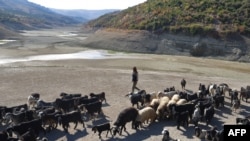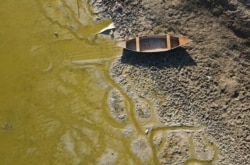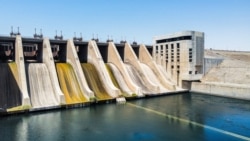With the Syrian civil war in its 10th year and more than half the country's population forcibly displaced by conflict, millions of Syrians face a new crisis: insufficient access to safe water that has increased food insecurity, diminished livelihoods and spurred further migration in search of resources.
According to an October 21 U.N Security Council report, people in Syria's north and northeastern regions remain unable to reliably access sufficient supplies of safe water. The reasons are both environmental and man-made.
According to the U.N.'s September 9 action plan to address the water crisis, 5.5 million Syrians' access to a critical water supply, the Euphrates River, is in jeopardy because of water levels that have been dwindling since January.
Less water flowing into the river from upstream, accompanied by irregular and reduced rainfall and higher-than-average temperatures, has created drought-like conditions in the region, according to the September U.N. report. The severity of the situation in Syria, say some experts, is largely attributed to the impact of climate change in the region.
Steven Gorelick is a senior fellow at Stanford University's Woods Institute for the Environment and director of its Global Freshwater Initiative, a program that aims to increase freshwater supplies in countries threatened by climate change, such as Jordan.
Gorelick said that the outcomes of his work in Jordan may be used to evaluate water scarcity in other Middle Eastern countries, such as Syria. Droughts occur regularly in the region and in Syria, with its naturally semi-arid climate, but are worsened by the present environmental crisis, he said.
"Given climate change, much of the Middle East is highly vulnerable to the impacts of drought, which in portions of the region will become more frequent, last longer and will be more severe," he said.
In addition to climatic factors precipitating the water crisis, civilian access to water has been further diminished because of the water supply systems.
According to the U.N. action plan, recurring shutdowns and "reduced operational capacity" of the Alouk water station in northeastern Syria has threatened about 500,000 people's direct access to water in the city of Al-Hasakeh and the surrounding region. Similar issues have occurred with the Al-Khafsa water station, which supplies Aleppo from the western bank of the Euphrates, and the nearby Ein El-Bayda water pumping station, which supplies an estimated 184,000 people with water.
Water treatment and sanitation plants are also critical to maintaining a safe water supply, but Rula Amin, senior communications adviser and spokesperson for the United Nations High Commissioner for Refugees (UNHCR) regional bureau for the Middle East and North Africa, said and the U.N. estimates some 50% of them are not functional.
The present situation is drastically different from 2011, the start of the Syrian crisis. At that time, more than 90% of the population had access to safe water, according to Amin.
'Bound to get worse'
The water crisis has led to larger problems for Syria. Water scarcity has damaged crops and agricultural livelihoods, decreasing access to food and dramatically raising the prices of food and basic goods. At least 12.4 million Syrians are estimated to be food insecure, according to the U.N. action plan, a figure that, along with malnutrition rates, will only worsen with drought.
The need for water, food and basic supplies can drive already displaced persons to migrate again.
"The crisis is bound to get worse. And we expect that it will lead towards displacement, and it will weaken people's ability to sustain their livelihood," Amin said.
U.N. researchers say the water crisis has also increased the prevalence of water-borne diseases, an added strain to Syria's public health system amid the COVID-19 pandemic.
The water crisis is yet another obstacle for Syrians to overcome while they continue to work toward a sense of normalcy following decades of conflict.
"It's that vicious, vicious cycle that is taking hold of the country and of the ability of the people to … even not just survive [but] to try to rebuild their life, to sustain a dignified level of living where they can actually maintain a good level for their well-being," Amin said.
The present U.N. plan to address the water crisis is aimed at ensuring 3.4 million people have access to safe water through rehabilitating water stations and supplies and improving water treatment, according to its September 9 report.
The U.N. is also working to address food insecurity, malnutrition and income loss, and to increase access to essential health services. Along with UNHCR, other agencies, such as UNICEF and the Food and Agriculture Organization, are working in Syria to address civilians' needs, according to Amin.
Sustainable, long-term solutions are required to address Syria's growing needs, which Amin stressed. That may begin with increasing the breadth of humanitarian operations inside the country.
"You have to invest in projects that will help alleviate the impact of this water crisis, and that doesn't happen within a one- or three-months project," Amin said.
Syrians must now live with an added level of pressure and uncertainty.
"I think people feel squeezed," Amin said. "It's hard to find a job, it's hard to put food on the table, it's hard to rebuild your house. … So [there] are very few options for them to look through where they see an opportunity, where … things will get better."













